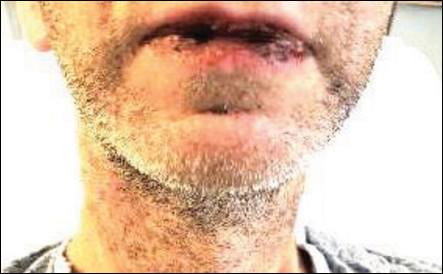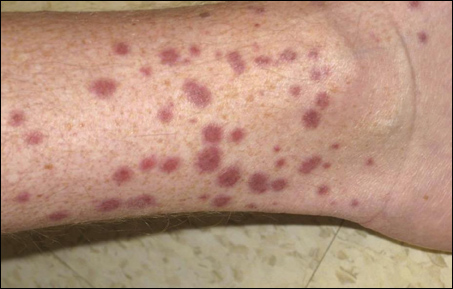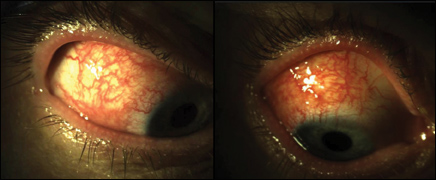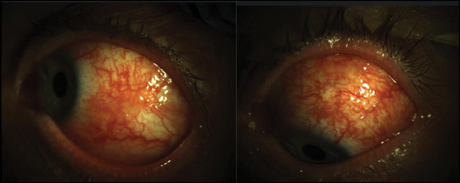Middle-aged man presents with bilateral conjunctivitis, mucositis, rash and fever
The upper and lower lids were erythematous with crusting at the lash line, and the bulbar and palpebral conjunctiva were diffusely injected.
A 43-year-old Caucasian man with a medical history of hypertension was transferred to Lahey Hospital and Medical Center from an outside hospital with a 2-week history of bilateral red eye, fevers, cough, myalgias and pain with swallowing.
Two weeks before presentation at our institution, the patient developed new-onset cough, fatigue and myalgias. Of note, the patient’s 4-year-old son had an upper respiratory tract infection 2 days before his symptom onset. The patient was seen at a local urgent care and prescribed oral azithromycin for presumed pneumonia. In the following days, he developed bilateral red eye associated with tearing and itching. Additionally, he had new-onset pain with swallowing, which prompted him to seek additional care at an outside hospital. A CT of the chest was ordered, which showed no evidence of pneumonia. On transfer to our institution, he was found to have bronchospasm, oral and genital mucositis, and an erythematous target maculopapular rash on his bilateral legs, palms and trunk (Figures 1 and 2). Ophthalmology was consulted to assess the patient’s ocular findings. The patient endorsed the simultaneous onset of bilateral red eye associated with crusting at his eyelid margins. He denied any changes in vision, photophobia or pain. He had no personal or family history of autoimmune or inflammatory disease.
Examination

Source: Alison J. Lauter, MD, and Naveen K. Rao, MD


On initial examination, the patient’s best corrected visual acuity was 20/20 in both eyes. Pupils were equal and reactive to light bilaterally without an afferent pupillary defect. IOPs were normal bilaterally. Confrontational visual fields were full in both eyes. Extraocular movements were full bilaterally. The bilateral upper and lower eyelids were erythematous with crusting at the lash line and watery discharge at the lid margin. The bulbar and palpebral conjunctiva were diffusely injected with a follicular reaction of the palpebral conjunctiva in both eyes (Figure 3). The corneas were clear, and anterior chambers were quiet without cell or flare. Fundus exam was within normal limits. No pre-auricular lymphadenopathy was noted.
What is your diagnosis?
See answer on next page.
Bilateral follicular conjunctivitis
Our patient was found to have bilateral follicular conjunctivitis associated with oral and urethral mucositis and a target maculopapular rash. The differential diagnosis of bilateral follicular conjunctivitis includes a variety of infectious causes including adenovirus, chlamydia, herpes simplex virus, Lyme disease and infectious mononucleosis. Stevens-Johnson syndrome, a severe hypersensitivity reaction, can also present initially with a follicular conjunctivitis. Additionally, a toxic follicular conjunctivitis can be seen in response to certain topical medications and should be considered in the differential.
The patient underwent an extensive systemic infectious and inflammatory workup for his constellation of symptoms. Infectious workup included cytomegalovirus PCR, herpes simplex virus I/II PCR, adenovirus PCR, coxsackie virus, Rocky Mountain spotted fever, human metapneumovirus, respiratory viral panel, Mycoplasma pneumoniae IgM/IgG, as well as blood cultures and urine cultures. Inflammatory and autoimmune workup included cold agglutinin, glomerular basement membrane antibodies, ANA, p-ANCA, c-ANCA, ESR and CRP. All labs were normal except M. pneumoniae IgM and IgG antibodies, which were elevated, along with a positive cold agglutinin, elevated ESR and elevated CRP. Skin punch biopsy of the patient’s rash showed vacuolar interface dermatitis with subepidermal blister formation, individual keratinocyte necrosis, focal full-thickness epidermal necrosis, and associated superficial mild lymphocytic inflammatory infiltrate. These biopsy results were consistent with a diagnosis of Stevens-Johnson syndrome (SJS). Based on the findings of the skin biopsy, lab work and clinical presentation, the patient was diagnosed with M. pneumoniae-associated SJS with ocular involvement.
Discussion
Stevens-Johnson syndrome is a rare disease characterized by an immune complex-mediated hypersensitivity reaction. The typical presentation involves a prodromal illness followed by mucous membrane disease and rash. SJS can cause significant morbidity due to scarring of the mucosal surfaces causing urethral and esophageal strictures as well as blindness. The classic skin lesions associated with SJS are maculopapules with a red center and white-surrounding area on an erythematous base. The fatality rate in adults is approximately 10%, most commonly due to sepsis and multi-organ system failure. SJS is classically associated with a medication hypersensitivity reaction, but various infectious etiologies have been recognized as inciting agents, such as M. pneumoniae, adenovirus and herpes simplex virus.
The classic ocular presentation in the acute phase of SJS includes mucopurulent or pseudomembranous conjunctivitis, episcleritis and iritis. Many patients will initially present with a nonspecific follicular conjunctivitis in the early stages of the disease, emphasizing the importance of a detailed review of systems and clinical evaluation. Late complications include conjunctival scarring and symblepharon formation, eyelid deformities and trichiasis, tear deficiency, corneal neovascularization, corneal ulceration, scarring and perforation. These complications are sequelae of the marked inflammatory reaction seen in the active phase of the disease, which leads to destruction of goblet cells. This results in decreased mucin production, which impairs tear distribution and stability, leading to cicatrization with healing.
Management of tear deficiency involves aggressive lubrication with preservative-free artificial tears, gels and ointments. In severe cases, topical cyclosporine, moisture chambers, tarsorrhaphy or punctal occlusion can be utilized. Topical steroids and cycloplegia should be used if iritis is present. Topical steroids may also be used for ocular surface inflammation. Daily pseudomembrane peels with a moistened cotton swab and symblepharon lysis to minimize scarring may be performed if present. Additionally, due to their inherent anti-inflammatory properties, the early placement of amniotic membranes has been a growing trend in the treatment of severe cases of acute SJS. The use of systemic corticosteroids remains controversial.
M. pneumoniae has been cited as the most common infectious agent associated with SJS. This organism is a common cause of respiratory tract infections, and while it is typically mild, 25% of patients can develop extrapulmonary complications. M. pneumoniae-associated SJS is most commonly seen in children and young adults, typically sparing the middle-aged and elderly population. Nearly all patients present with oral involvement, and approximately two-thirds of patients have ocular involvement. Case series studies have shown that M. pneumoniae-induced SJS cases manifest with less severe and less frequent complications than drug-induced forms, suggesting a more favorable prognosis in this subset of patients.
Clinical course continued


Our patient was started on artificial tears four to eight times per day, erythromycin ophthalmic ointment in both eyes at night and cool compresses for presumed viral conjunctivitis. Systemically, the patient was started on a 5-day course of azithromycin for treatment of presumed Mycoplasma infection and oral prednisone 60 mg daily for treatment of his mucositis. The patient also received symptomatic treatment with oral analgesics for his mucositis and bronchodilators for his respiratory symptoms.
On day 6 of admission, the diagnosis of M. pneumoniae was confirmed, and the patient was discharged on day 7 of hospitalization. He was seen the next day in the outpatient clinic and found to have superior and temporal conjunctival epithelial defects in both eyes (Figures 4 and 5). The patient was started on tobramycin-dexamethasone drops in both eyes four times daily, which was then tapered off over 3 weeks, and continued on erythromycin ointment in both eyes at night. There was no evidence of corneal epithelial defects or symblephara. The tobramycin-dexamethasone drops were tapered over the following weeks given gradual improvement in clinical exam. On the final 3-week follow-up, the conjunctiva in both eyes was healed, and the patient remained off any therapy. His rash and mucositis resolved completely.
- References:
- Catt CJ, et al. Am J Ophthalmol. 2016;doi:10.1016/j.ajo.2016.03.020.
- Chang YS, et al. Cornea. 2007;doi:10.1097/ICO.0b013e31802eb264.
- Olson D, et al. Pediatrics. 2015;doi:10.1542/peds.2015-0278.
- Saeed HN, et al. Curr Opin Ophthalmol. 2016;doi:10.1097/ICU.0000000000000312.
- For more information:
- Alison J. Lauter, MD, and Naveen K. Rao, MD, can be reached at New England Eye Center, Tufts University School of Medicine. 800 Washington Street, Box 450, Boston, MA 02111; website: www.neec.com.
- Edited by Aubrey R. Tirpack, MD, and Astrid C. Werner, MD. They can be reached at the New England Eye Center, Tufts University School of Medicine, 800 Washington St., Box 450, Boston, MA 02111; website: www.neec.com.
